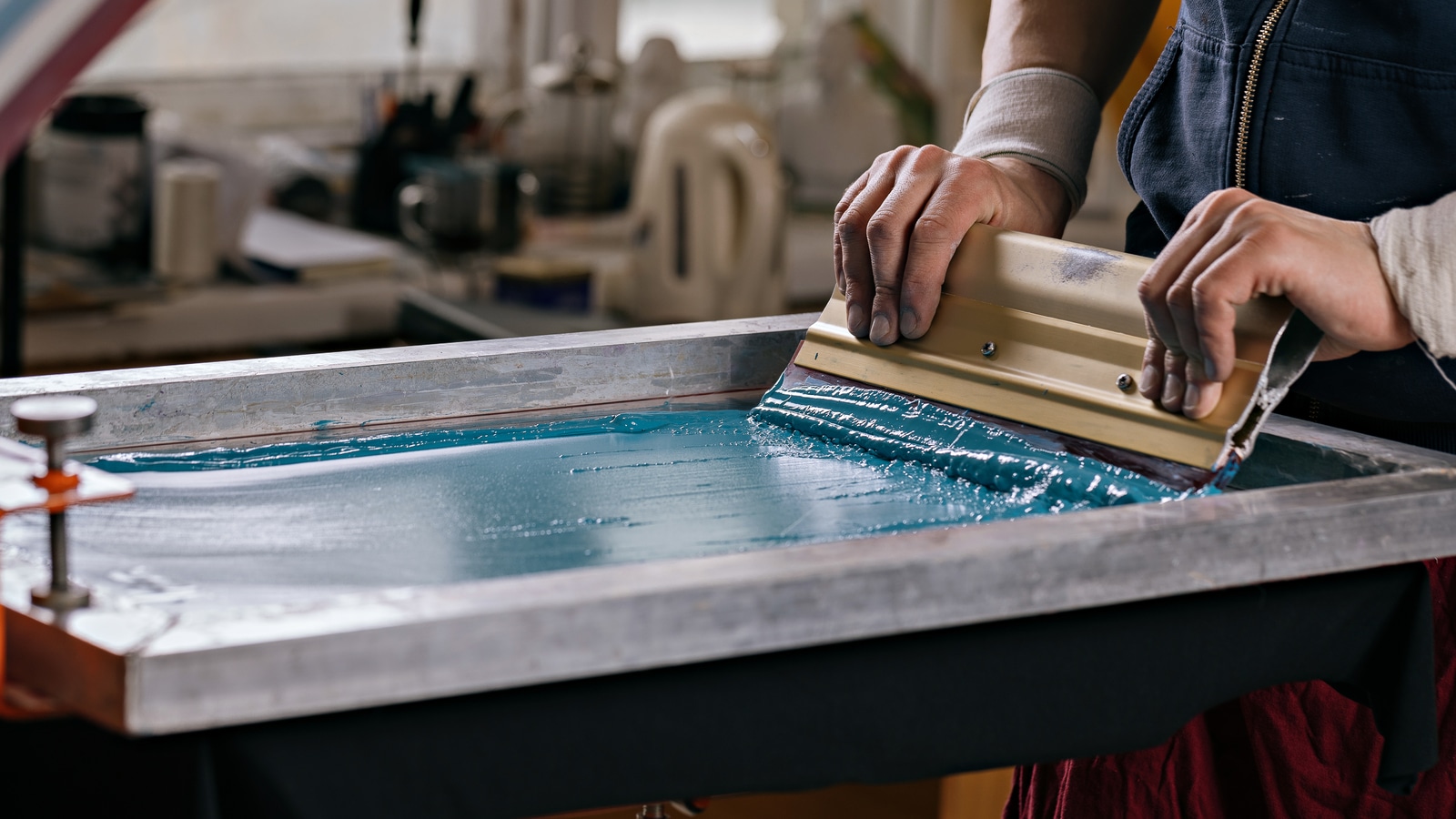Beginner-Friendly Screen Printing Kit for DIY Projects
Beginner-Friendly Screen Printing Kit for DIY Projects
Blog Article
Screen Printing Uncovered: Every Little Thing You Need to Find Out About Tee and Garment Printing Strategies
If you have actually ever questioned just how those lively styles wind up on your preferred t-shirts, you remain in the right location. Screen printing is an interesting method that combines art with strategy, using unlimited possibilities for creativity. Understanding the principles, from equipment to ink options, can considerably influence your outcomes. Ready to discover the necessary elements that make screen publishing an art form? Let's uncover the details that can raise your projects.
The Basics of Display Printing: How It Works
When you plunge right into screen printing, you'll find it's both a scientific research and an art. At its core, display printing involves creating a stencil, or screen, that allows ink to pass through just in details locations.
Setting the screen over the textile, then make use of a squeegee to press ink through the display onto the garment. Each action is important, and mastering them will boost your display printing abilities, changing easy garments into one-of-a-kind, expressive pieces.
Sorts Of Display Printing Techniques
Once you understand the basics of screen printing, it's time to discover the different methods that can boost your layouts. One prominent technique is standard screen printing, where ink is pushed with a stenciled screen. This technique is wonderful for vibrant, vivid shades. There's water-based ink printing, which provides a softer feel and is environmentally friendly, but it requires a various strategy to healing.
Another option is plastisol printing, understood for its sturdiness and vivid shades, making it a favored for numerous brands. Experiment with halftone printing to develop slope results and detailed designs.
Necessary Devices for Screen Printing
To achieve magnificent results in screen printing, having the appropriate devices is essential. You'll require a strong display printing framework, which holds the mesh that transfers your style onto the garment. Next off, invest in premium squeegees; these are necessary for using ink uniformly across the display.
Choosing the Right Inks and Materials
When choosing inks and products for display printing, you require to think about the sort of ink that works best for your project. Think of fabric compatibility to assure your layouts look fantastic and last long. Likewise, check out green ink options to make your printing process more lasting.
Types of Display Inks
Choosing the ideal screen ink is crucial for attaining dynamic, durable prints that fulfill your project's demands. There are a number of kinds of display inks to take a look at. Specialized inks, such as glow-in-the-dark or metal, can include distinct impacts to your designs.

Fabric Compatibility Factors To Consider
Comprehending textile compatibility is essential for accomplishing high-grade screen prints, particularly since various products respond uniquely to various inks. When selecting inks, take into consideration the fabric type-- cotton, polyester, or blends. For cotton, water-based inks function well, supplying soft qualities and breathability. Polyester, on the various other hand, commonly needs plastisol inks for much better adhesion and vivid shades. You may need to make use of a mix of both types if you're printing on blends. Constantly check your inks on sample fabric to guarantee they stick properly and keep shade stability. In addition, maintain in mind that textile weight and appearance can influence the last end result, so selecting the right ink and product combo is crucial for your task's success.
Eco-Friendly Ink Options
Environment-friendly inks are coming to be a popular choice for screen printers who want to lessen their ecological influence while keeping top quality. When selecting inks, consider water-based inks, which are less unsafe and easier to clean up compared to conventional solvents.
In addition, look for inks made from renewable energies, such as soy or vegetable-based choices. By selecting the ideal inks and materials, you'll not only create spectacular designs but also contribute to a click to read more lasting printing procedure. Make the switch, and your prints will reflect your commitment to the environment!
Preparing Your Style for Screen Printing

File Style Demands
To guarantee your layout looks lively and sharp on fabric, you'll require to pay close attention to file style needs for display printing. Make certain your design has a transparent background to avoid undesirable white edges on your prints. Maintain shade modes in mind; CMYK is common for display printing, so transform your RGB creates appropriately.
Color Separation Techniques
Color splitting up is an essential step in preparing your design for screen printing, and mastering it can considerably improve your print quality. You'll need to damage your style right into private colors, as each shade calls for a different screen throughout printing. Beginning by recognizing all the shades in your style and produce layers for each one. You can utilize software application like Adobe Photoshop or Illustrator to isolate and separate shades properly. Be particular to save each layer as a different file, typically in a style like TIFF or PSD. This precision not just ensures accurate shade depiction but additionally simplifies the printing process. By taking note of shade splitting up, you'll achieve expert and vibrant cause your screen-printed garments.
Resolution and Size
Attaining the finest results in display printing starts with ensuring your layout has the ideal resolution and size. Preferably, your artwork needs to additional hints be at the very least 300 DPI (dots per inch) for sharp, clear prints. If you utilize lower resolution, your end product may look unprofessional and pixelated.
When it concerns size, consider the dimensions of your print area. Layout your artwork to match the last print dimension, preferably producing it in the actual measurements you'll be publishing. In this manner, you'll prevent any type of unforeseen scaling concerns.
Constantly inspect your layout in both vector and raster formats. Vector graphics can be scaled without losing high quality, making them excellent for screen printing. Preparing properly will ensure your style looks incredible on every garment!
Step-by-Step Screen Printing Process
Display printing is a vibrant process that enables you to produce dynamic styles on various surfaces. To obtain begun, you'll require a screen, emulsion, and your chosen ink.
Put ink onto the display and make use of a squeegee to press the ink through the pattern onto the fabric. Lift the screen very carefully and let the print completely dry. You've successfully display published your design.
Tips for Successful Display Printing Projects
While you're diving right into your display printing projects, keep in mind that prep work is key to success. Begin by gathering all your materials-- inks, garments, screens, and squeegees. A tidy workspace helps prevent undesirable mistakes, so clean prior to you begin.
Next, verify your artwork is high-resolution and correctly sized for your garment. Examine your display for appropriate exposure and tidy it completely to stay clear of smudges. When blending your inks, follow the maker's guidelines to attain the best consistency.
Throughout printing, use even stress with your squeegee for regular outcomes. Do not rush; take your time to confirm each print fulfills your standards. After printing, let your garments completely dry entirely prior to dealing with or packaging them.
Lastly, constantly maintain a sample of your work for future referral. In this manner, you can analyze your progress and boost your techniques gradually. Happy printing!

Often Asked Questions
How much time Does It Take to Establish a Display Printing Task?
Establishing a display printing task generally takes around thirty minutes to an hour. You'll prepare the screens, mix inks, and readjust journalism. The moment varies based on intricacy and experience, so remain organized!
Can I Print on Various Material Keys In Using the Same Strategy?
Yes, you can print on different material types making use of the same strategy, yet you'll require to change your inks and setups. Some textiles absorb ink differently, so experimenting assurances the most effective outcomes for every product.
What Prevail Blunders to Stay Clear Of in Screen Printing?
When display printing, stay clear of typical blunders like using the wrong ink, ignoring correct direct exposure times, or avoiding pre-press checks. Constantly check your configuration and maintain clean displays to ensure top quality results each time.
Just How Can I Appropriately Tidy and Maintain My Screen Printing Equipment?
To properly clean and maintain your display printing tools, you need to routinely clean screens with proper solvents, check mops for wear, and ensure all tools are stored completely dry and dust-free. Uniformity stops pricey fixings and boosts performance.
Is Display Printing Environmentally Pleasant Contrasted to Other Techniques?
Screen printing can be much more eco-friendly than other approaches, especially if you utilize eco-conscious materials and water-based inks. By selecting lasting products and practices, you minimize waste and decrease your effect on the world.
Screen Printing Uncovered: Every Little Thing You Need to Know About Tee Shirt and Garment see this site Printing Methods
At its core, display printing involves producing a pattern, or display, that allows ink to pass with just in specific locations. Position the display over the fabric, then make use of a squeegee to press ink via the display onto the garment. One popular method is conventional screen printing, where ink is pushed with a stenciled display.When picking inks and products for display printing, you require to take right into account the kind of ink that functions finest for your job.
Report this page